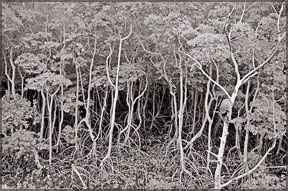Protecting mangrove forests
by Vishaka Senadhira
Mangrove forests or mangals are truly a beautiful gift of mother
nature. The word mangroves means the 'tropical seashore trees with many
tangled roots above ground.'
Mangroves are tropical communities. They could be found along the
coast and is usually exposed to the high and low tides. The height of
the tidal water level, as well as the salinity of the water constantly
maintain the surroundings of the mangrove communities. Mangroves or
mangals develop where the wave action is absent and the sediments
accumulate.

Mangrove communities could be found in lagoons, river estuaries and
also in the shores of deeper lagoons. Mangroves are scattered into about
15 districts of Sri Lanka.
The largest mangroves are seen in the Jaffna peninsula, Mulative,
Trincomalee, Potuvil, Ratgama, Maduganga, Chilaw, Wantavilluwa, Mannar
etc.
There are small mangal communities along the coastline from Panadura
to Bundala. In mangrove communities you can find two kinds of species
viz. true mangroves and mangrove associates.
True mangroves are specifically adopted to mangrove conditions. Some
of the species of this category are Rhizophora (maha kadol), Avecennia,
Ceriops, Luminitzera, Bruguiera (mal kadol) etc. Mangrove associates
usually arise in coastal and in inland habitats. Acanthus, Calophylun,
Acrostichum, Tamarix etc. are some of the species in this category.
Mangroves are found in the low lying muddy areas. The soil in the
mangrove forests always come in contact with the sea water. Hence the
waters in these communities are always high in salinity. The soil is
muddy. It is water logged and poorly aerated.
Mangrove forests are strongly influenced by the tides. the nutrients
are brought to the ecosystem by the incoming tides. Zonation is one of
the features of tidal fluctuation; which means the changes in vegetation
from seaward edge to true terrestrial environment.

The red mangroves (Rhizophora mangle) experience the deepest tidal
action so they occupy the seaward edge. The black mangroves (Avicennia
germinanas) which are next, are familiar with shallow floods caused by
the high tides. White mangroves (Lagncularia racemosa) dominate the edge
landward.
Since the water in the mangrove communities is high in salinity the
water absorption by the plants may be difficult. The mangrove species
have adopted to such conditions of high salinity. The botanists have
proved scientifically that the osmotic pressure of the cells of these
plants is high. That's why these plant species absorb water from the
hyper-saline water.
The mangrove plants are adopted to retain the absorbed water. Many
plants have shiny, thick, fleshy leaves. E.g. Rhizophora, Ceriops,
Soneratia, Aegicerus etc.
The leaves of some plants are also adopted to reduce the water loss
from the plants. The soil of the mangroves are usually water logged and
is poorly aerated. Certain mangrove species like Sonneratia (Kirala)
have special, kind of roots called 'pneumatophores' or 'pencil roots'.
They grow against the gravity, so they could be seen clearly
protruding above water. They can absorb the atmospheric oxygen.
In Bruguiera (mal kadol) the 'knee roots' could be seen above water.
They are like loops and absorb the air from the atmosphere.
In the mangroves the soil is loose and muddy. The trees of the
mangroves usually grow up to a certain height, and some kind of
anchorage is necessary for these plants.
There are two kinds of roots that help in anchoring the mangrove
plants to the soil.
Prop roots
These arise from the main trunk of the plant and grow into the soil.
Thus extra strength is provided to the plant. E.g. Rhizophora
Stilt roots
They emerge from the branches of the mangrove plants and grow into
the soil. E.g. Ceriops
Both these roots prevent the plants being uprooted due to the action
of the tides. Many plants of this community germinate while being
attached to the parent plant. After germination they fall out. This way
the seeds do not come in contact with the saline water which could be
harmful for the germination of the seeds.
Fauna in mangroves
Mangroves are usually rich in fauna. A variety of animals which are a
mixture of terrestrial and marine life live within them. Fiddler crabs,
(Uca spp) and some other land crabs make borrows in the soil.
Some major carnivores like alligators, crocodiles, bears, big cats
(like tigers) exist in the inner portions of these forests. Some aquatic
birds like herons and bitterns live on the branches of many mangrove
species. Littorina snails could be seen attached to the prop roots or
the large trunks of the plants of the mangrove forests.
These ecosystems serve as excellent breeding grounds for fish,
shrimp, crab or prawns. The fruit and bark of certain mangrove species
have a medicinal value. They have been used to cure boils, rheumatism,
eye infections etc. The pulp of some species are used to make tannin,
rayon, lacquer, etc. The mangroves play a huge role of protecting our
coasts from erosion.
Human impact
Statistics show that mangroves of the Pacific and Persian Gulf
regions have been exploited by men. It also says that some have never
been recovered. In Vietnam, large areas of mangroves have been
completely damaged due to the Vietnam war.
In Sri Lanka these forests have been utilised in imbalanced ways by
humans. The tsunami, which we experienced two years ago was violent on
our island due to the lack of a barrier such as the mangroves along the
costal belt. These forest areas are polluted with numerous toxic
material, like various types of polythene and plastic. This will become
lethal to the fauna and flora of our mangroves.
It's time to take action. The concerned authorities should implement
projects on a large-scale to restore and protect our mangroves. At the
same time the public should be made aware of the importance and
protection of mangroves.
Many awareness programmes which also includes active participation,
should be held at school level to educate our future generations. |
